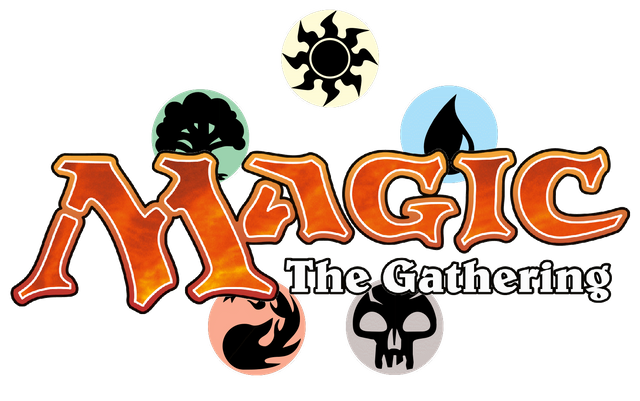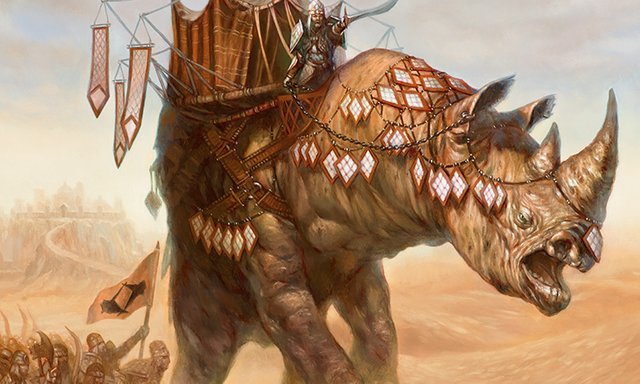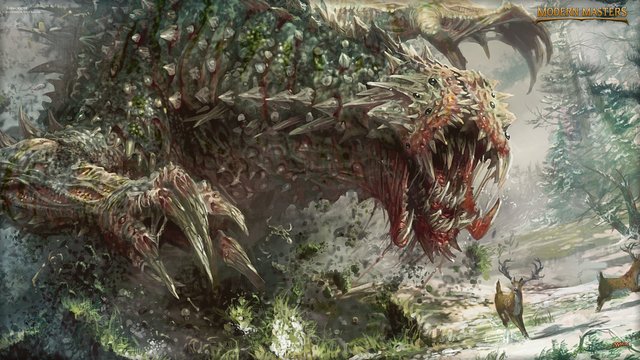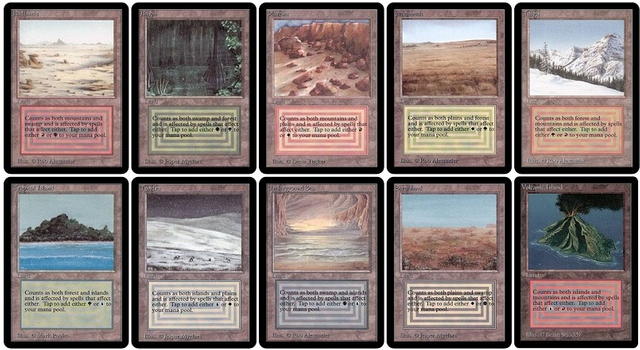The Cyrptocurrency before Cryptocurrency

Magic: The Gathering is a collectible/trading card game created by Richard Garfield from Wizards of the Coast (WOTC) in 1993. It was heavily inspired by Dungeons and Dragons and established itself early on as the first and most in-depth card game. Over 20 years later, Magic: The Gathering has been so successful that the only serious competition has been Hearthstone, which is entirely digital. In addition to being a well-designed game that is excellent fun to play with friends, Magic: The Gathering has a very in-depth economy due to the vast secondary market. Wizards of the Coast does not influence the secondary market directly, nor do they take much action at all to change prices. The Magic secondary market is almost entirely market-driven.
To understand how Magic's secondary market works I will go through the major formats of the game and how this fits in to the unregulated and free card market.

LIMITED
Limited is the only format of Magic: The Gathering with no significant secondary market. As the name implies, this format is very limited and players can build decks only out of cards they open from booster packs. There are two ways to play limited: draft and sealed.
Draft requires 8 players sitting around a table who each have 3 booster packs. They open a pack, pick one card from it, then pass the pack on the the next player. This repeats in opposite directions each pack until all cards have been chosen. Players then build 40 card decks with the cards they have chosen and play 3 rounds. Whoever emerges 3-0 is the winner. This is highly profitable for WOTC because they sell packs at a profitable price and everyone must have booster packs in order to play.
Sealed is a lot simpler than draft. Each player opens 6 booster packs and makes a deck from those cards. This is more profitable to WOTC than draft because it involves twice the packs, though players greatly prefer draft because it is more interactive, more fun, and more skill based.
Since cards must be used from booster packs, there is little way for a secondary market to function. However, there is a small market for out-of-print booster packs for players to draft for fun among themselves. This consists mostly of memorable, important, old or goofy sets. The interest in drafting old sets is low so the market is too niche to have any worth.

STANDARD
From WOTC's official site,
Each year, four Magic sets are released and added to Standard. Those sets are grouped into two-set blocks (For example: Shadows over Innistrad and Eldritch Moon are a block). Once per year, when the first set of the second block releases, the two oldest blocks in Standard rotate out.
The standard format contains all cards from sets from the last one and a half years, including a ban list that is rarely used. Standard is the most popular constructed format in Magic. Constructed, for the initiated, refers to formats where players build their own decks using cards that are legal in the format. Standard, since it uses current cards, makes sense to be the most popular because all the cards opened from draft can be played in standard, with some exceptional exclusions. The ban list, which has recently been made use of, primarily deals with cards that warp the meta, are overpowered, broken, unfair or draw the games out too long. This does not affect the secondary market as a whole too much, but it does affect the value of the cards being banned in most circumstances. Since there must be clear problems with certain cards and certain decks to warrant an investigation into what must be banned, players can usually tell what is on the chopping block and what is safe.
The secondary market for standard is very substantial draft as mentioned earlier. Players can draft for fun and use the cards they opened to trade with other players for other cards, resulting in mutually beneficial exchanges and sometimes, unfortunately, scams. The ability to trade cards is not regulated by any body. WOTC barely references the secondary market in any of their statements. The value of a card is determined by basic economics: supply and demand. Not only can cards be exchanged for other cards with other players for what is agreed upon to be "a fair trade", Magic cards could be sold for various different currencies, with Magic going up in search popularity on ebay every time a new set drops. The secondary market can be very profitable if you are smart. The secondary market can also be driven by tournaments. Winning decks can shoot up in price due to the sudden and significant jump in demand. This applies to all formats and the price of a card is determined by several factors that all come back to a simple supply and demand.
The image used above, a card called Siege Rhino, is a fascinating example of a card and had an effect that we should hope cryptocurrency will fall in to. Siege Rhino was a very powerful card. Many players called it the most powerful card in standard at the time and a lot of players called for bans because they thought it was too oppressive. The metagame was shifted around the card completely, yet Siege Rhino was not banned. It got to a point where some players were trying to force a strange and glass-cannon deck structure in order to play Siege Rhino. The demand was very high, so you would have expected Siege Rhino to wave a high price, however, the set it was from, Khans of Tarkir (very high powered set, very well designed mechanics, excellent reception all around,) was one of the most opened in recent Magic history. This meant that the supply was also very high. High demand and high supply? The circulation of Siege Rhino was large and it maintained a very consistent price of about $6-7 for its entire run in standard. Cryptocurrency doesn't have the Siege Rhino equivalent yet. Cryptocurrency is in dangerous period where there is massive growth and massive crashes. What it needs to be stable is a high demand for crypto met with a high supply of crypto. The alt-coin market is a bloodbath like the 2016 Republican Primaries: too many candidates trying their best to be on top.
It must be noted that standard cards generally drop in value by very significant margins (up to 80%) once they are no longer legal in standard. It is a short term market, like many alt-coins, that you have to be aware of in order to not lose big. Magic makes it clear when this drop will be, but cryptocurrency is uncharted waters, even after half a decade.

MODERN
Modern is the older brother of standard. It contains cards from a set called Mirrodin, from October 2003, and onwards, which extends to all sets that were at one point standard legal (which excludes supplemental products and goofy joke sets). Modern, since it has a far larger card pool, has a more diverse metagame than standard and a broader secondary market. The cards can be a lot older in modern which results in lower supply and higher prices. Many of these low supply cards are staples which are coveted by players due to their high value and high usefulness in the game.
The ban list in modern has a bigger effect on the secondary market than standard does. Since standard bannings will only occur in extreme circumstances, WOTC is less conservative about banning modern cards. Certain cards have been banned due to metagame dominance and being too consistently powerful, others for being so broken that only an idiot would design a card like it, and some notorious cards that were banned for the sole reason of prolonging the length of a game to such ridiculous times that tournaments could go hours overtime. When WOTC bans a card from modern, it can make an entire deck or entire archetype unplayable. This can result in huge price crashes, but, more often than not, most cards will retain value due to versatility and being used in multiple decks. WOTC in modern are like the Federal Reserve. Nobody wants them to be there, but they do have an important role in keeping the game fun and healthy.
The pictured card is called Tarmogoyf. It has a low cost for generic stats that can change based on the state of the game. For a very long time, Tarmogoyf was like a Bitcoin. Very high demand, comparatively low supply and high price. WOTC, acting like the Federal Reserve, acted out of character, which they very rarely do, and reprinted Tarmogoyf, as well as some other cards, to increase the circulating supply of Tarmogoyfs which was supposed to decrease the price. And it worked. This was a positive move for the players but a warning sign for market players. Magic's great strength as a pseudo-cryptocurrency is that WOTC very rarely does anything regarding the secondary market. They can never regulate it, but pseudo-monetary policy can disrupt the market in various ways.
However, it must be noted that the decrease in Tarmogoyf's price due to the increase in supply increased the demand of cards played in decks with Tarmogoyf, which in turn increased their price. The overall price of the decks Tarmogoyf was in decreased, but it wasn't a significant decrease. Magic has an interesting phenomena where when one card in a deck increase or decreases in price, other cards played in that deck will increase or decrease in opposing directions. My personal modern deck, Jeskai control, shot up in price after it won a pro-tour, but has gradually decreased in price due to a greater availability of staple cards. Certain cards dropped in price a lot, but others increased as well. For two or three years, the deck maintained a very consistent price of around USD$1000. It has now dropped to USD$930, which is significant drop if accounting for inflation. The good news is that at any point in time I could trade out of my cards to get that money in cash. The popularity of the game and the format make investments somewhat viable, though not as viable as when we get to the next format.
Modern can be compared to current-period Bitcoin. Relatively stable and high price, moderate supply, moderate-high demand. If you invest in modern you can make money if you choose the right cards at the right times. Bitcoin is similar. Just as certain cards can be banned and tank prices of a deck, Bitcoin can face serious crashes and it's best to get out before this happens. Sometimes it's hard to predict, other times it's obvious and there's no excuse but ignorance.

LEGACY
Legacy is an old format. All card dating from the beginning of Magic are allowed to be played, extensive ban list excluded. For the most part, legacy is the grandfather of modern. Very low supply, moderate demand, very high barrier to entry. What sets legacy apart is the reserve.
The reserve list is a list of cards that WOTC has vowed to never reprint. The supply is capped. No more of these cards are in print and they will never be in print again. Obviously, this vastly increases the value of all cards on the reserve list, however, there are a lot of cards on the reserve list which were knee-jerk reactions to what WOTC thought were very powerful cards at the time but have aged poorly. They still retain value for virtue of being old and collectors items, but the real value from the reserve list lies in the land.
The picture above contains the original dual lands. The land mechanics in Magic are complex and there's no point explaining them in detail here. All that needs to be known is that every competitive legacy deck needs these original dual lands and there is a very low supply. The prices of these cards has been increasing steadily for years. They never crash and never rally. Slow turtle increases.
I foresee that Bitcoin of the future may tread the path of legacy. We are nearing Bitcoin's limit and that may increase the value and keep it stable. We should also not discount the possibility that Bitcoin could become the bad reserve list cards that nobody wants since they were obsoleted by better, newer and more available cards.

If you wish to learn more about Magic's economy and the metagame, I would highly recommend against it. You first need to learn the game to understand all the mechanics. It took me over 6 months to become confident with the rules and a bit less to get a good handle on metagames and Magic history. I must admit that it is very interesting and very fun to learn more about this game.
I have left above a poorly photographed image of my deck. It cost about USD$1000 and I have spent the time to learn the ins and outs of it. In doing so, I have learned about the Magic economy, which led me to create this post. Magic does have a lot of parallels with cryptocurrency and it has taught me how to think towards the future while understanding all of what makes something tick. Cryptocurrency is quite a bit more complicated (Read: to several orders of magnitude) than Magic, but any preparation is good preparation.
Your Post Has Been Featured on @Resteemable!
Feature any Steemit post using resteemit.com!
How It Works:
1. Take Any Steemit URL
2. Erase
https://3. Type
reGet Featured Instantly – Featured Posts are voted every 2.4hrs
Join the Curation Team Here
@originalworks